Top trends in benefits of omnichannel customer service for 2025

Businesses in 2025 achieve remarkable results by embracing the benefits of omnichannel customer service. Companies using omnichannel see up to a 287% higher purchase rate, 89% customer retention, and 9.5% annual revenue growth. Sobot AI and Sobot call center solutions enable seamless transitions, hyper-personalization, and smarter data insights. These trends in digital-first customer service improve every customer service experience. Enhanced analytics and AI-driven support set new standards for customer experience trends. The table below highlights key benefits of omnichannel customer service:
| Benefit Description | Statistic / Percentage |
|---|---|
| Purchase rate increase with omnichannel | Up to 287% higher purchase rate |
| Year-over-year customer retention increase | Up to 91% greater retention |
| Customer lifetime value increase | 30% higher lifetime value |
| Customer retention (strong vs weak strategy) | 89% vs 33% retention rate |
| Annual revenue growth | 9.5% yearly increase vs 3.4% for non-omnichannel |
| Shopping frequency | Omnichannel customers shop 1.7 times more |
| Customer favorability for quick response | 54% favor brands that respond quickly |
| Customer retention with omnichannel | 89% retention rate |
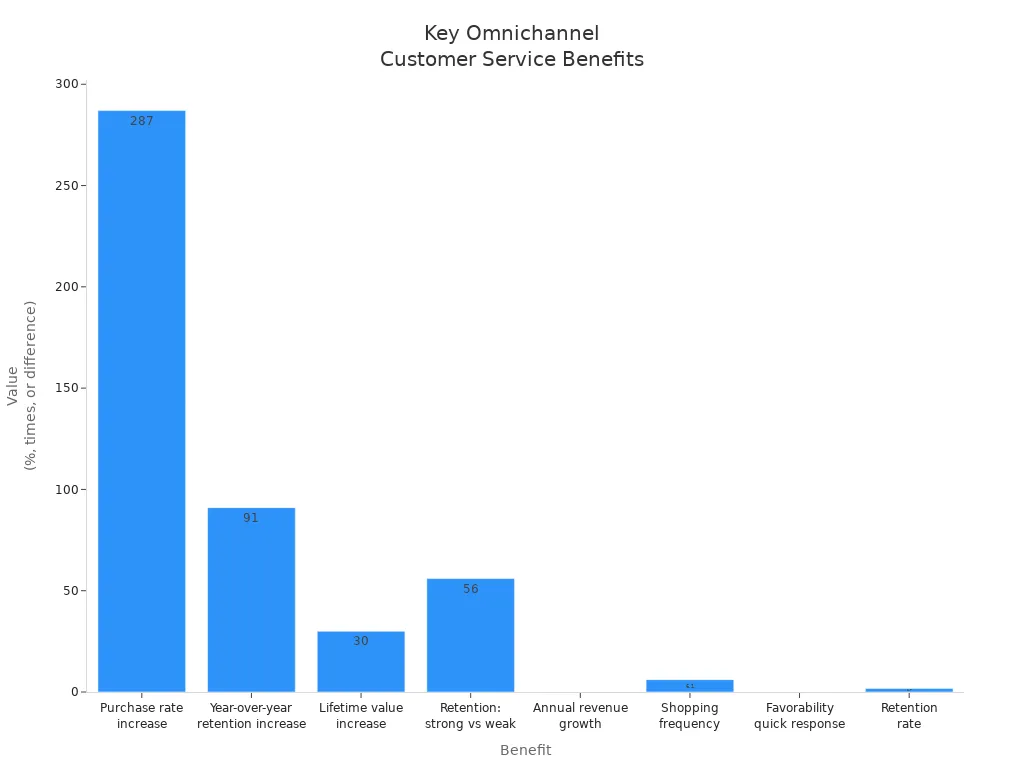
Seamless Omnichannel Support
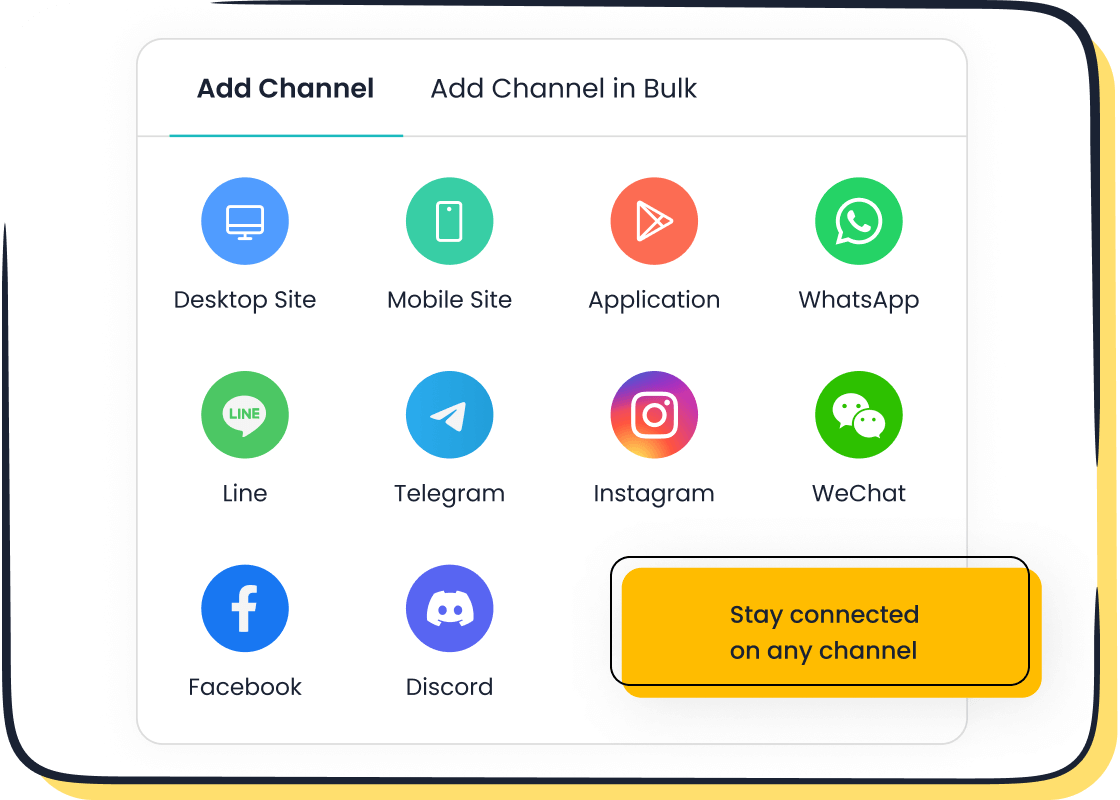
Unified Customer Experience
Seamless omnichannel support transforms the customer journey by removing barriers between communication channels. Customers expect to move from digital interactions on a website to a mobile app or social media without losing context or repeating information. Omnichannel customer experience integrates all touchpoints, ensuring a consistent user experience. Companies that align teams and unify customer data see a 22% increase in satisfaction and a 21% boost in revenue, according to Aberdeen. Harvard Business Review reports that organizations prioritizing customer experience generate 60% higher profits.
- Omnichannel support eliminates channel silos by:
- Integrating communication channels for a unified customer view.
- Allowing customers to switch platforms without interruption.
- Providing agents with full context of previous interactions.
- Reducing customer effort and wait times.
- Increasing satisfaction and loyalty.
Real-world examples show that brands like Starbucks and Sephora achieve higher retention by aligning teams and using shared metrics. Customers can start shopping on a mobile device and finish on a laptop, never losing progress. This approach leads to 250% higher purchase and engagement rates and 90% higher retention compared to single-channel or multichannel strategies. Effective onboarding and personalized support further increase loyalty, with 86% of customers more likely to stay when their experience feels seamless and engaging.
Integration with Sobot
Sobot delivers seamless omnichannel support by unifying customer service across voice, chat, email, and social media. Its AI-powered Live Chat platform brings all conversations and customer data into one workspace. Agents gain instant access to customer history, enabling fast, informed responses. Sobot’s omnichannel solution automates routine inquiries with chatbots and voice assistants, providing 24/7 support and reducing agent workload. Businesses use Sobot to analyze customer behavior, launch proactive outreach, and personalize marketing campaigns. By 2025, 95% of customer service interactions will involve AI, making Sobot’s tools essential for delivering a consistent omnichannel experience. Companies using Sobot report higher satisfaction, faster resolution times, and improved customer loyalty.
Tip: A unified omnichannel strategy not only improves customer satisfaction but also drives measurable business growth. Source: Harvard Business Review
Hyper-Personalization Trends
Data-Driven Personalization
Customer service trends in 2025 focus on hyper-personalization powered by advanced AI and machine learning. Companies now analyze large datasets in real time to understand individual needs and predict future behavior. Retail apps use location and purchase history to offer highly relevant recommendations. AI-powered chatbots and virtual assistants handle diverse inquiries, making customer service more efficient. These trends mark a shift toward proactive customer experience, where AI anticipates issues and offers solutions before customers even ask.
- Hyper-personalization evolves beyond basic personalization:
- AI predicts customer needs and delivers recommendations before requests.
- Generative AI agents use natural language processing for human-like conversations.
- Marketing shifts from broad messaging to targeted engagement based on specific customer data.
- Brands like Netflix and Amazon use AI-driven recommendations to simplify choices and reduce decision fatigue.
Sobot’s omnichannel solution leverages these trends by unifying data from all touchpoints. Its Live Chat platform uses AI to provide personalized customer service, guiding users with tailored suggestions and real-time support. This approach ensures consistent customer experience across every channel.
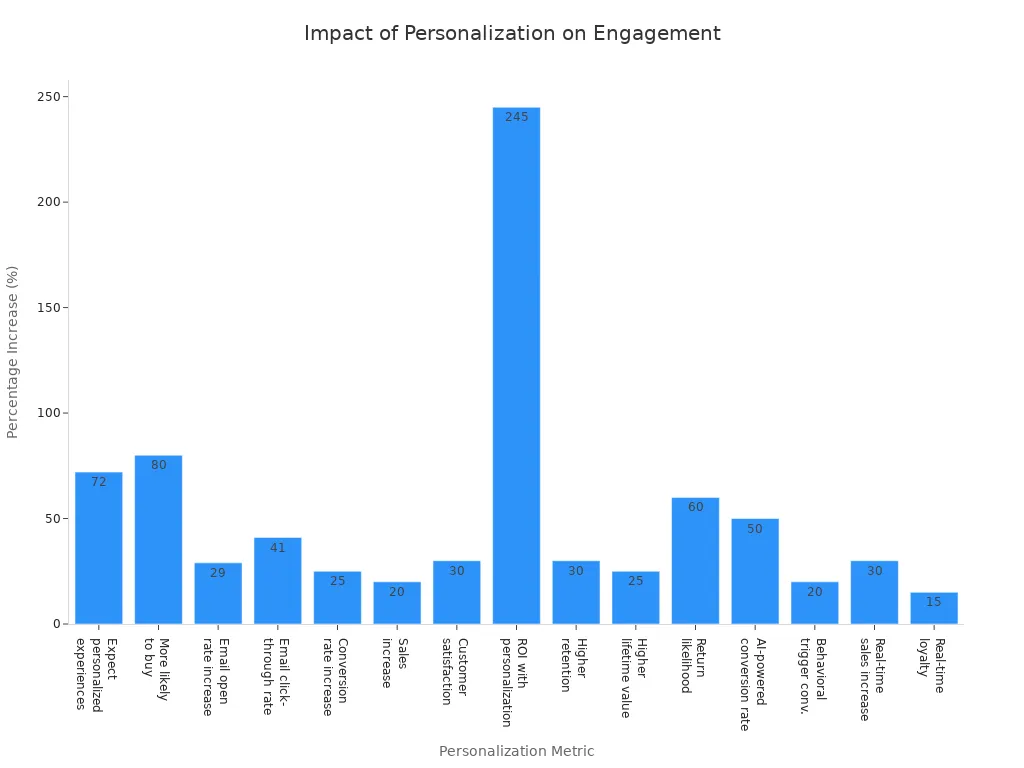
A recent report shows that 72% of consumers expect companies to tailor experiences. Personalized emails increase open rates by up to 29% and click-through rates by 41%. Companies using AI-powered personalization see a 50% increase in conversion rates and a 20-30% boost in sales (source). These customer service trends drive higher engagement and satisfaction.
Customer Loyalty Benefits
Hyper-personalization in customer service trends leads to stronger loyalty. When companies use integrated omnichannel data, they identify and engage customers more effectively. A case study found that hyper-personalization strategies increased the proportion of fully identifiable customers from 16.53% to 31.37%. This migration supports higher engagement and retention.
Personalized customer service relies on a strong data foundation. Real-time identification allows brands to deliver personalized interactions, such as loyalty programs and targeted offers. Customers who receive relevant communication feel valued and understood. This approach prevents churn and increases lifetime value.
Sobot’s AI-driven tools help businesses design loyalty programs based on detailed customer profiles. By connecting digital and physical interactions, Sobot enables brands to deliver seamless, personalized experiences. These customer experience trends ensure that customers return more often and remain loyal.
Note: Companies that invest in hyper-personalization see a 30% higher retention rate and a 25% increase in customer lifetime value (Forrester). Customer service trends in 2025 make loyalty a key outcome of personalized interactions.
AI in Omnichannel Customer Service
Automation and Efficiency
Customer service trends in 2025 highlight the growing impact of AI and automation in omnichannel environments. Businesses now use AI-powered chatbots to handle up to 80% of routine customer inquiries. This shift reduces wait times and allows human agents to focus on complex issues. Predictive analytics and intelligent routing direct customers to the right resource, improving first-contact resolution by up to 40%. These trends lead to faster responses and higher satisfaction.
A recent HubSpot survey found that 90% of customers value immediate responses. Self-service portals and knowledge bases help customers solve problems on their own, which increases satisfaction and reduces agent workload. Companies measure improvements using Net Promoter Score (NPS), Customer Satisfaction Score (CSAT), and Customer Effort Score (CES). Increased use of automation tools in customer service trends correlates with higher CSAT and better resolution rates.
The table below summarizes the most impactful AI applications in omnichannel customer service for 2025:
| AI Application | Description | Reported Benefits / Impact |
|---|---|---|
| Predictive Analytics | Forecasts issues and needs, enabling proactive support | 25-40% better resolution, 15-30% higher satisfaction |
| Emotion AI | Detects and responds to customer emotions | More empathetic, human-like interactions |
| Ambient Intelligence | Anticipates needs and enables seamless, invisible support | Contextual assistance, proactive care |
| NLP & Conversational AI | Provides 24/7, human-like chat and voice support | 85% of interactions managed by AI (Gartner) |
These trends show that digital-first support and automation are now essential for delivering efficient, personalized customer service.
Sobot Live Chat AI Tools

Sobot Live Chat stands out in customer service trends for 2025 by integrating advanced AI and automation across all channels. Sobot’s AI tools automate operations, including review analysis and ticket resolution, which saves both time and costs. The platform uses natural language processing (NLP) and sentiment analysis to detect emotional cues like sarcasm or empathy, allowing agents to respond with greater understanding.
Sobot employs predictive analytics and behavioral modeling to identify dissatisfaction and forecast CSAT trends. This proactive approach helps businesses address issues before they escalate. Sobot’s AI-powered chatbots provide 24/7 support, automating routine tasks and improving the quality of customer interactions. The system aggregates feedback from social media, support tickets, and calls, giving a unified view of customer satisfaction.
Key features that differentiate Sobot Live Chat AI tools include:
- Automation of customer service tasks, reducing response times.
- Deep sentiment analysis for more empathetic responses.
- Predictive analytics for proactive support and loyalty improvement.
- Real-time feedback integration from multiple channels.
These trends in customer service ensure that companies using Sobot deliver faster, more personalized, and more effective omnichannel experiences. As customer service trends evolve, Sobot’s AI and automation capabilities help businesses stay ahead in 2025.
Enhanced Self-Service
Chatbots and Knowledge Bases
Modern customer service relies on advanced self-service customer support tools. AI-powered chatbots and comprehensive knowledge bases now handle a wide range of customer inquiries. These solutions provide instant answers, reduce wait times, and allow customers to resolve issues at any hour. Companies see significant cost savings by using chatbots, which manage queries for as little as $0.50 per interaction compared to $8–$15 for live agents. Knowledge bases serve as a single source of truth, ensuring customers receive consistent and accurate information.
| Metric/Example | Evidence |
|---|---|
| Cost per interaction | AI chatbots: $0.50–$0.70 vs. live agents: $8–$15 |
| Ticket deflection | Self-service solutions deflect 30–60% of incoming tickets |
| Cost reduction | AI chatbots can reduce support costs by 30–40% |
| Resolution rates | Vodafone’s TOBi chatbot resolved 70% of inquiries, raising NPS by 14 points |
| Alibaba case study | AI chatbots handled 75% of queries, saving $150 million and increasing satisfaction by 25% |
Sobot’s self-service customer support platform combines AI chatbots with a robust knowledge base. This integration enables businesses to deliver 24/7 support, automate routine tasks, and provide accurate answers quickly. Sobot’s system uses retrieval-augmented generation (RAG) to improve chatbot accuracy, ensuring customers receive up-to-date information. As a result, companies using Sobot experience faster resolutions and lower operational costs.
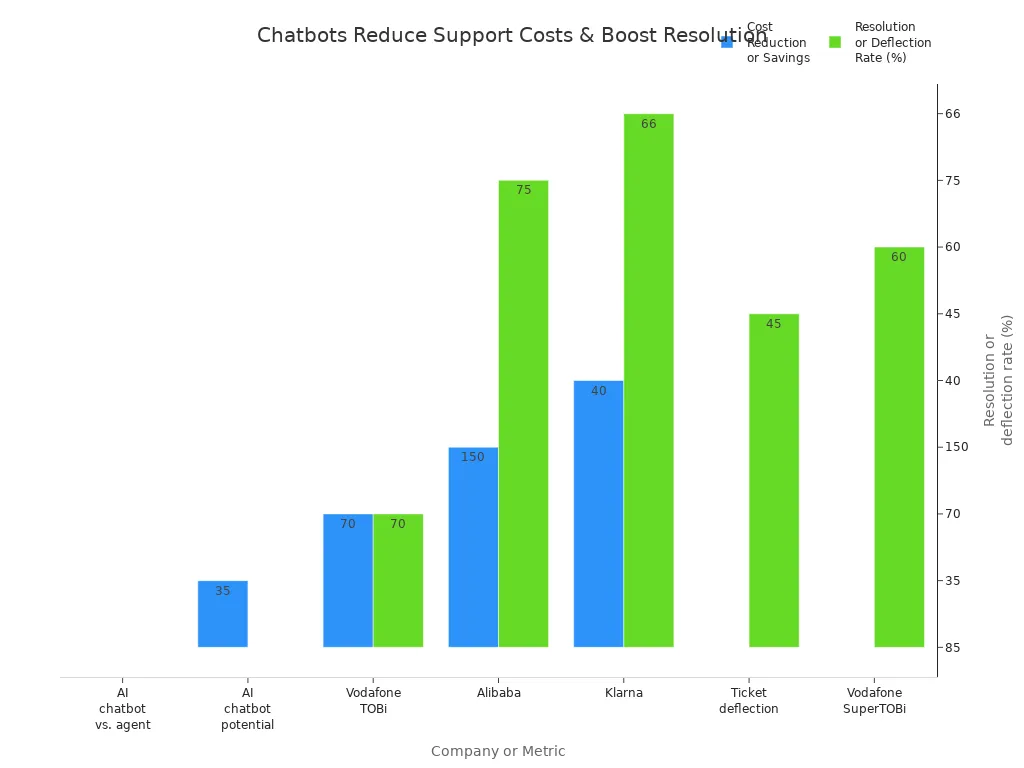
Customer Empowerment
Self-service customer support empowers individuals to solve problems on their own terms. Customers prefer to find answers without waiting for live agents. This approach leads to higher satisfaction and stronger brand loyalty. For example, Amazon’s customer satisfaction score reached 83/100 in 2023, partly due to detailed product information and unbiased reviews. Hulu maintained a churn rate near 1% by offering personalized recommendations and omnichannel support.
A recent study found that 77% of customers believe brands could do more to earn their loyalty. Self-service capabilities reduce transaction abandonment and improve retention. Companies that offer robust self-service customer support see a 37% increase in self-service requests year over year. Sobot’s platform supports this trend by providing intuitive tools that guide users through common issues, enhancing engagement and satisfaction.
Customers expect seamless, flexible service. Self-service customer support meets these expectations, leading to improved Net Promoter Scores and long-term loyalty.
Data Insights for Customer Experience
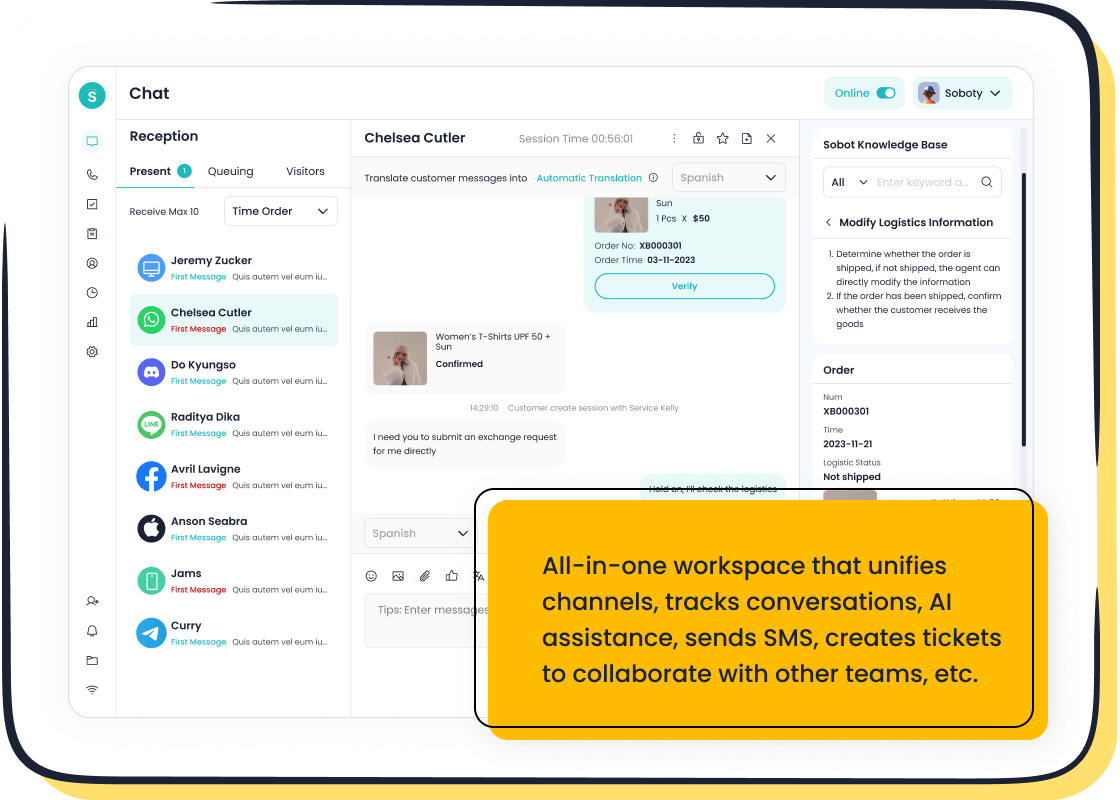
Analytics in Omnichannel
Data-driven contact centers now play a crucial role in shaping the omnichannel customer experience. Companies use advanced analytics tools to unify data from every channel, creating a complete view of each customer. Tools such as Google Analytics, Tableau, and Customer Data Platforms help businesses track interactions, measure satisfaction, and identify trends in real time. These platforms offer customizable dashboards and robust integration, making it easier to spot opportunities and address issues quickly.
Sobot’s omnichannel solution brings all customer data into a single workspace. Agents see every interaction, from live chat to voice calls, which helps them deliver faster and more accurate support. This unified approach improves first call resolution rates and boosts customer satisfaction. For example, Nissan Europe adopted a mobile-first omnichannel strategy, combining Rich SMS and app notifications. The result was a fourfold increase in engagement and an 80% conversion rate for new campaigns. SYRSA, a Spanish automotive group, improved call center efficiency by 60% and raised customer satisfaction by using an integrated omnichannel platform.
The table below highlights how leading companies use data insights to enhance customer experience:
| Industry | Company/Tool | Data Insight Application | Outcomes/Impact |
|---|---|---|---|
| Retail | Sephora Virtual Artist | AI-powered virtual try-on tool providing personalized experiences and collecting customer data | 50% increase in engagement, 20% sales growth, improved marketing and customer experience |
| Banking | JPMorgan Chase | AI virtual assistants maintaining conversation context across channels | 20-30% higher satisfaction, 10-20% lower support costs |
| Telecom | T-Mobile Unified Customer View | AI integration of multi-source customer data for 360-degree view and personalized recommendations | Faster resolutions, higher loyalty, fewer complaints |
Companies that invest in analytics for omnichannel strategies see measurable gains in loyalty, retention, and operational efficiency. Sobot’s built-in analytics and customer feedback analysis tools help businesses optimize every touchpoint, ensuring a seamless experience in 2025.
Proactive Support
Proactive support has become a defining feature of modern omnichannel customer experience. Data-driven contact centers use real-time analytics and customer feedback analysis to anticipate needs and resolve issues before they escalate. By monitoring behavior and sentiment, companies can identify at-risk customers and intervene early. This approach reduces churn and builds trust.
Industry benchmarks show that proactive support, powered by data insights, lowers churn rates and increases satisfaction. A SaaS provider reduced churn by 35% within weeks after integrating AI-powered proactive support. Companies achieve these results by sending personalized tips, checking in regularly, and addressing complaints quickly. Real-time analysis of churn patterns and direct feedback collection uncover hidden issues, allowing targeted improvements.
Sobot’s omnichannel platform empowers businesses to deliver proactive support across all channels. The system uses predictive analytics to forecast customer needs and automate outreach. Agents receive alerts about dissatisfied customers, enabling fast intervention. This strategy leads to a 95% increase in customer satisfaction and a 30% boost in productivity, as shown in recent case studies.
Tip: Proactive support, enabled by analytics and customer feedback analysis, helps companies in 2025 maintain high retention and deliver exceptional customer experience.
Trust and Transparency
Secure Omnichannel Interactions
Trust forms the foundation of every successful omnichannel strategy. Customers want to know their data stays safe when they interact with brands across retail, social media, and digital platforms. Leading companies follow strict practices to protect customer information and comply with privacy regulations. These practices include:
- Clear communication about how data is collected and used.
- Consent management, giving customers control over their data-sharing preferences.
- Secure data storage on certified servers, such as those with GDPR and ISO27001 certifications.
- Encryption of data both in transit and at rest.
- Role-based access control, so only authorized staff can view sensitive information.
- Regular audits and employee training on privacy regulations.
- Incident response plans to manage and report data breaches quickly.
For example, Sobot’s omnichannel platform uses advanced encryption and secure storage to protect customer data. The system supports explicit consent management and regular compliance audits, helping businesses meet global standards like GDPR and CCPA. These measures reduce legal risks and build trust with customers. Companies that follow these steps show a commitment to privacy and security, which is essential in today’s retail environment.
Tip: Secure omnichannel interactions not only protect data but also improve customer experience by reducing anxiety and building confidence.
Building Customer Confidence
Transparency in customer interactions drives long-term loyalty and confidence. Studies show that 94% of consumers stay loyal to brands that offer complete transparency (Label Insight). In retail, customers want to know how their data is used and expect honest communication about products and services. Brands that align their messaging with real business practices build credibility and trust.
- 81% of consumers need to trust a brand before making a purchase (Edelman Trust Barometer).
- 70% of shoppers will pay more for products from brands they trust (Global Web Index).
- Transparent loyalty programs increase member retention by 10%, and 63% of customers share positive experiences with others.
Retail customer experience improves when companies communicate openly about sourcing, timelines, and challenges. For example, Everlane’s “Radical Transparency” approach, which shares true product costs and sourcing details, led to a 90% year-over-year growth rate. Patagonia’s open environmental campaigns resulted in a 30% sales increase and positioned the brand as a leader in ethical retail.
Sobot helps businesses maintain transparency by providing clear communication tools and customer feedback analysis. The platform enables brands to share updates, collect feedback, and respond quickly to concerns. This approach builds emotional connections and encourages repeat business.
Note: Transparency and trust in omnichannel strategies lead to higher loyalty, increased revenue, and a stronger retail customer experience.
Real-World Results: Sobot Customer Story
Opay Case Study
Opay, a leading financial service platform, faced challenges managing high volumes of customer interactions across multiple channels. The company needed a solution to unify its customer service and marketing efforts. By adopting Sobot’s omnichannel customer service platform, Opay transformed its approach to customer experience and support.
After implementing Sobot’s solution, Opay achieved remarkable results:
- Customer satisfaction rate increased from 60% to 90%.
- Operational costs dropped by more than 20%.
- Conversion rate rose by 17%.
- Integration of WhatsApp Business Account enhanced marketing capabilities.
- Customer service efficiency and internal collaboration improved significantly.
Sobot’s omnichannel customer service platform unified Opay’s communication channels, including social media, email, and voice. The Live Chat feature provided agents with a single workspace, allowing them to access customer history and respond quickly. The WhatsApp Business API enabled targeted marketing campaigns, reaching customers where they are most active. These improvements reflect the latest customer service trends, where seamless support and hyper-personalization drive loyalty and growth.
Business Impact
Sobot’s implementation delivered measurable business impact for Opay. The table below summarizes key improvements in business metrics:
| Business Metric | Impact Description | Quantitative Improvement |
|---|---|---|
| Customer Satisfaction | Enhanced through immediate multi-channel response capabilities | Improved customer satisfaction scores by over 30% |
| Response Time | Reduced by streamlining customer support operations | Faster responses, leading to higher satisfaction |
| Revenue (Inferred) | Boosted through better customer engagement and operational efficiency | Conversion rates increased by over 15% |
| Net Promoter Score (NPS) | Increased via personalized promotions and enhanced purchase experiences | NPS improved by over 35% |
Sobot’s integration with WhatsApp Business API and chatbot automation streamlined Opay’s support operations. Response times dropped, and agents managed inquiries more efficiently. The support team’s workload decreased, allowing them to focus on strategic tasks. Improved operational efficiency and customer engagement contributed to revenue growth, demonstrating the value of omnichannel customer service in today’s customer experience landscape.
Opay’s success story highlights how adopting omnichannel customer service solutions like Sobot can transform customer experience, boost satisfaction, and drive business growth. For more details, visit Sobot’s official customer stories.
The benefits of omnichannel customer service in 2025 include seamless, personalized support, improved efficiency, and higher revenue. Companies adopting customer service trends like AI-powered chatbots, unified data, and proactive support gain a clear competitive edge. Sobot and Live Chat help organizations deliver these benefits by integrating all channels and using analytics for better decisions. To leverage these trends:
- Audit your customer journey for gaps.
- Train agents for omnichannel fluency.
- Invest in AI and unified data platforms.
Companies mastering these customer service trends see up to 91% retention and 40% more revenue (McKinsey). Now is the time to act and unlock the full benefits of omnichannel customer service.
FAQ
What is omnichannel customer service and why does it matter in 2025?
Omnichannel customer service connects all communication channels, such as chat, email, and social media, into one seamless experience. In 2025, 89% of customers expect brands to remember their history across channels. This approach increases satisfaction and loyalty. Source
How does Sobot improve omnichannel customer service?
Sobot unifies conversations from websites, apps, and social media in a single workspace. Agents access customer history instantly. Sobot’s Live Chat and AI tools automate routine tasks, reduce response times, and boost conversion rates by up to 38%. This leads to higher customer satisfaction.
What are the top customer service trends for 2025?
Key customer service trends include hyper-personalization, AI-driven support, proactive outreach, and secure data management. Companies using omnichannel customer service platforms like Sobot see up to 91% retention and 9.5% annual revenue growth. These trends help businesses stay competitive.
How does Sobot ensure data security in omnichannel customer service?
Sobot uses advanced encryption, GDPR-compliant storage, and role-based access controls. Regular audits and consent management protect customer data. These measures build trust and support secure omnichannel customer service for industries like finance, retail, and gaming.
Can Sobot’s Live Chat integrate with other business systems?
Yes. Sobot’s Live Chat integrates with CRM, e-commerce, and ticketing systems. This integration helps agents provide personalized service and track customer journeys. Businesses gain a unified view, which improves efficiency and supports omnichannel customer service strategies.
See Also
Comprehensive Overview Of Omnichannel Call Center Platforms
Step-By-Step Process For Deploying Omnichannel Contact Centers
Revealing The Best Cloud Contact Centers For 2025
